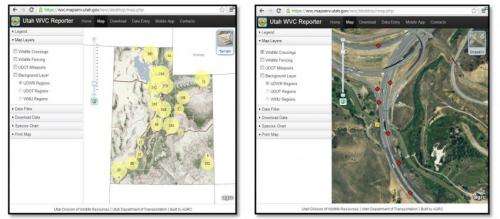Spatial patterns in wildlife-vehicle collisions can be efficiently analyzed at both broad (left image) and fine (right image) scale extents using the WVC Reporter map viewer. Credit: PLoS ONE 9(6): e98613. doi:10.1371/journal.pone.0098613
A new app used to report wildlife-vehicle collisions increased efficiency and accuracy when compared to manual methods, according to a study published June 4, 2014 in the open-access journal PLOS ONE by Daniel Olson from Utah State University and colleagues.
Wildlife-vehicle collisions (WVC) endanger both humans and wildlife. Understanding when and where these collisions occur is essential to mitigating risks, but collecting this information requires an efficient and accurate system. Because data is currently gathered manually scientists aimed to develop and test a smartphone-based system for reporting, collecting, and managing WVC data that is improved over the manual method. The new WVC Reporter system consists of a mobile web application for data collection, a database for centralized storage of data, and a desktop web application for viewing data.
During the first year of use, ~6,800 animal carcasses were reported using WVC Reporter. Reports that used the app produced more accurate locations, were entered quicker, and had a lower data entry error rate than manual reports. The desktop web app improved access to WVC data and allowed users to easily visualize wildlife-vehicle collision patterns at multiple scales. Overall, the system increased reporting efficiency, improved accuracy, and enhanced data visualization. In addition, the authors conclude that development costs were minor relative to the potential benefits of having spatially accurate and temporally current wildlife-vehicle collision data. This app and collected data may be useful to protect both drivers and wildlife.
More information: Olson DD, Bissonette JA, Cramer PC, Green AD, Davis ST, et al. (2014) Monitoring Wildlife-Vehicle Collisions in the Information Age: How Smartphones Can Improve Data Collection. PLoS ONE 9(6): e98613. DOI: 10.1371/journal.pone.0098613
Journal information: PLoS ONE
Provided by Public Library of Science





















